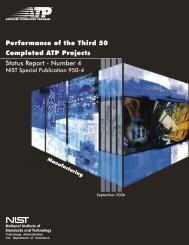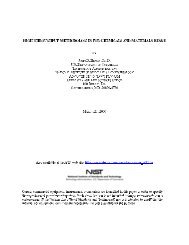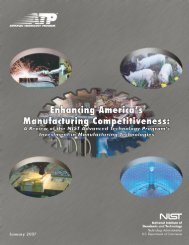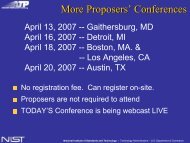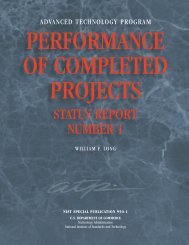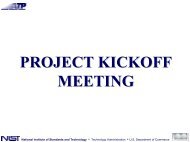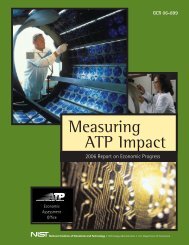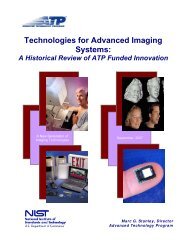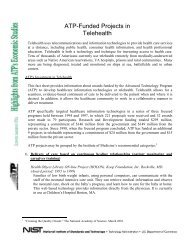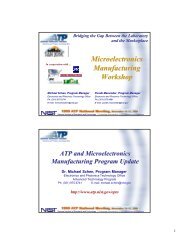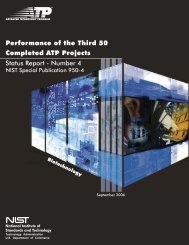Direct and Spillover Effects of ATP-Funded Photonics Technologies
Direct and Spillover Effects of ATP-Funded Photonics Technologies
Direct and Spillover Effects of ATP-Funded Photonics Technologies
- No tags were found...
You also want an ePaper? Increase the reach of your titles
YUMPU automatically turns print PDFs into web optimized ePapers that Google loves.
material reliability issues. The speed <strong>and</strong> contrast performance <strong>of</strong> laboratory device LC <strong>and</strong>FLC chemical materials tends to decay rapidly with repeated use over time, which would beunacceptable in commercial products. Displaytech tackled this in two ways, with a materialsformulation <strong>and</strong> a contrast compensator. Materials formulation involved developing a bettermix <strong>of</strong> ingredients. Narrowly, the specific mixture developed under <strong>ATP</strong> funding is used nowonly in minor products, so has quite limited measurable value. More broadly, several corecomponents identified under <strong>ATP</strong> funds in that mix are now in use in improved mixes tohelp stabilize Displaytech’s proprietary FLC materials.Most importantly, though, Displaytech principals believe the <strong>ATP</strong> funding enabled them todevelop a methodical discipline for developing FLC materials reliability. “We’d never gonethrough the discipline,” said one. “Though we were doing interesting chemistry, we’d nevermade the transition to device grade materials…. What are all the parameters that matter?How do you build a metrology around those parameters?” Another added, “We’d neverdone reliability qualifications <strong>of</strong> FLC material before then. In fact, no one had.” Displaytechhas since investigated more than 5,000 different formulations <strong>and</strong> transitioned intocommercial-grade compositions. Without the disciplinary approach, they believe, they couldnot now be mass manufacturing. Although the original Displaytech proposal to <strong>ATP</strong>discussed the need for improved materials reliability, the broader formalization <strong>of</strong> thediscipline was a more important lasting result, perhaps inevitable given the goal, butunforeseen nonetheless. In contrast to the trade secret glue deposition process, Displaytechhas since been patenting FLC material formulations. This patenting behavior is typical in thechemical industries, as chemicals are more straightforward for competitors to learn throughreverse engineering <strong>of</strong> products in the market than are manufacturing processes. 14A related area <strong>of</strong> work begun under <strong>ATP</strong> to improve the commercial lifetime <strong>of</strong> the FLCmaterials <strong>and</strong> devices involved a so-called contrast compensator. This was related to the issuethat the LC materials tend to degrade chemically if the net drive voltage across them is notzero. 15 Because these devices use DC power to drive them, the “on” voltages needcounterbalance from an opposite signal to net to zero. The traditional method in an FLCdisplay would be to show a positive image frame, <strong>and</strong> then electrically send the negative <strong>of</strong>the same frame, but visually black it out with a fast shutter so the visual result is not acontrastless, neutral gray wash. The trouble with this shuttering approach is it reduces thebrightness <strong>and</strong> effective frame rate in the visual signal. Displaytech, under <strong>ATP</strong>, insteadstarted developing an additional active optical element that selectively reverses thepolarization, turning each negative frame positive, while leaving positive frames. Thiscontrast compensator eliminates the need to shutter out the negative signal. It is separatefrom the microdisplay itself, but it also uses an FLC layer because it has to switch just asfast. Displaytech has patented their technique.A final important technical result was an improved manufacturing process for singulation—scribing <strong>and</strong> separating—<strong>of</strong> the multiple microdisplays that are manufactured on a single14. See, for example, Mansfield (1986).15. Underwood (1997).22 DIRECT AND SPILLOVER EFFECTS OF <strong>ATP</strong>-FUNDED PHOTONICS TECHNOLOGIES



